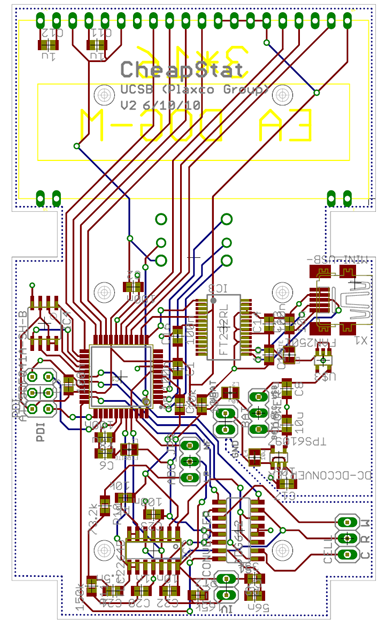Team:UC Davis/Potentiostat Design
From 2014.igem.org
| Line 1: | Line 1: | ||
{{Team:UC_Davis/Head}} | {{Team:UC_Davis/Head}} | ||
{{Team:UC_Davis/projectMenu}} | {{Team:UC_Davis/projectMenu}} | ||
| + | {{Team:UC_Davis/imageSlider}} | ||
<html> | <html> | ||
<head> | <head> | ||
Revision as of 06:18, 15 October 2014
Inspiration & Iteration
Inspiration & Iteration
Software
Software & Downloads
Get Started!
Getting Started



Circuit Abstract


- SLIDE 4
Our biosensor required a potentiostat. A potentiostat is an instrument capable of maintaining a voltage bias between electrodes.
The bias encourages diffusion but more importantly the transfer of electrons which are recorded, and ultimately related to the species present in solution. We were faced with the decision to buy or build.
Unfortunately, there weren't any entry-level potentiostats that met our requirements, and commcercial potentiostats are in the thousands of dollars. We needed a cheaper solution if we wanted our device to be consumer friendly. We researched the literature for potentiostat circuits and were presented with the CheapStat.
Inspiration and Iteration

 The CheapStat is a budget friendly device developed at UC Santa Barbara several years ago. We aspired to build this circuit and modify the software for our purposes, however, the microcontroller on the CheapStat was controlled predominantly in machine level code. The learning curve seemed unreasonable considering our deadline, so we had to find another solution.
The CheapStat is a budget friendly device developed at UC Santa Barbara several years ago. We aspired to build this circuit and modify the software for our purposes, however, the microcontroller on the CheapStat was controlled predominantly in machine level code. The learning curve seemed unreasonable considering our deadline, so we had to find another solution.
We were ultimately forced to build our own. With a clean slate, we wanted to create a device that would fulfill our needs, but also be welcomed by the iGEM community. We aimed to match the performance of the CheapStat, but also improve in three ways: increase the effective range of the instrument, decrease the cost of the circuit, and convert to an arduino-friendly microcontroller. In this capacity, we have succeeded.
We modeled our circuit after the CheapStat, eventually including more than 30 components. We went on to create five iterative prototypes. The schematic and board files for the various prototypes are all available here. To read more about our inspiration and circuit design, click here.
Software Design
 The OliView software was written in C++ within the Qt Creator IDE. The backend of the software includes the GNU-licensed library QCustomPlot for graphing, and the open-source biquad library by Nigel Redmon, for digital signal processing. These elements have been incorporated with more than 1,200 lines of UC Davis code to create a feature-rich environment for controlling the OliView potentiostat. Our progress was updated through the UCDiGEM OliView Github . We included features for statistical analysis as well a .CSV exporting feature
The OliView software was written in C++ within the Qt Creator IDE. The backend of the software includes the GNU-licensed library QCustomPlot for graphing, and the open-source biquad library by Nigel Redmon, for digital signal processing. These elements have been incorporated with more than 1,200 lines of UC Davis code to create a feature-rich environment for controlling the OliView potentiostat. Our progress was updated through the UCDiGEM OliView Github . We included features for statistical analysis as well a .CSV exporting feature
The downloads section includes all the files necessary to build and run the OliView system. Schematic and board files for the OliView potentiostat are provided in Eagle V6.6 format. CAM processing files have been optimized for production by Seeed Studios, Inc.The files are all being released under the MIT(?) Open Source Initiative License.
Getting Started
There five easy steps to getting started:
1. Order the PCB and the parts from the parts list.
 "
"